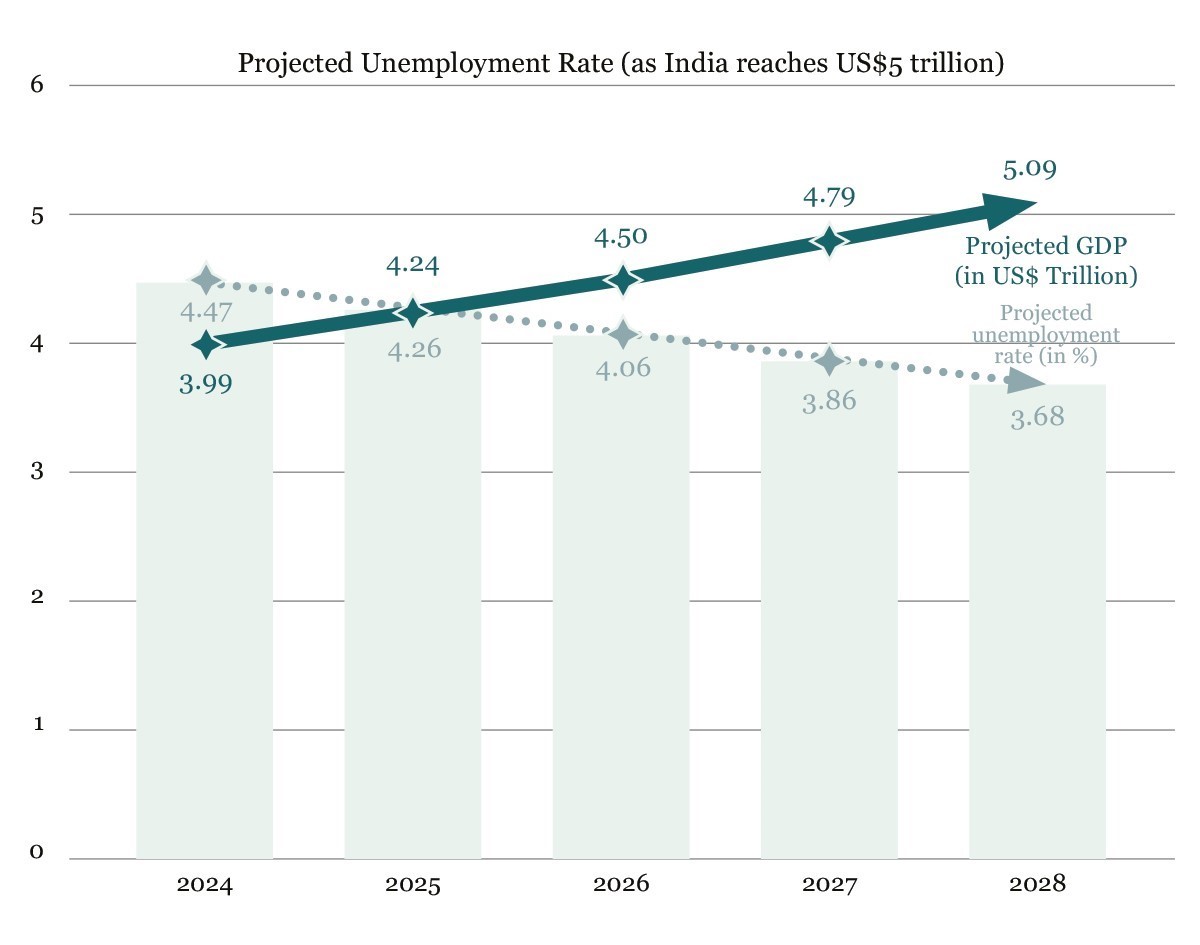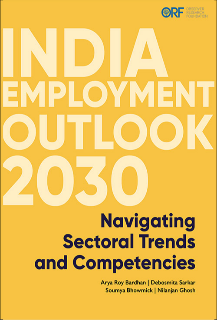Executive Summary
India’s job market is experiencing a transformation as the country has become the world’s fastest growing large economy in the aftermath of the COVID-19 pandemic. The country’s young population, whose median age is 28.4 years, holds a key to fuelling economic expansion. With a GDP growth rate of 7.8 percent, India could potentially achieve its target of becoming a US$5-trillion economy by 2026-27, with such growth being underpinned by strong private consumption and public investment.
These goals are set against the ongoing shifts in the global landscape and dynamics of manufacturing, brought about by the pandemic, geopolitical tensions, and supply disruptions. Notably, the import demand of the United States (US) has pivoted away from China towards India due to the latter’s competitive cost structure, abundant labour resources, and burgeoning domestic market. In India, manufacturing is a vital sector that has consistently contributed 17-19 percent to the Gross Value Added (GVA). The Indian government has prioritised manufacturing through initiatives such as Make in India, Production Linked Incentive Schemes, and SAMARTH Udyog. The service sector also contributes a significant share to the GVA, exhibiting potential for generating employment and boosting economic growth.
Despite its contributions to the economy, employment in the manufacturing sector has stagnated and even declined, especially in the urban sector, over the last decade. Technological advancements have led to a declining capital-to-output ratio and an increasing capital-to-labour ratio, which raise questions about the manufacturing sector’s capacity to continue absorbing India’s expanding workforce. The employment outlook for India’s manufacturing sector suggests that overall employment in the sector will continue to decline.
Which job markets should India’s youth look to in the next decade?
Fig. 1: Projected Unemployment Rate in India

Source: Authors’ own, using data from IMF[1] and ILO[2]
With the highest employment elasticity to economic growth, India’s service sector presents a promising outlook. This report illuminates ten opportunity sub-sectors within the service sector that have the greatest potential for growth and employment generation for the Indian economy by 2030. These opportunity sectors are: digital services (Fourth Industrial Revolution or 4IR, content economy); financial services (banking and insurance); health services; hospitality services; consumer retail services; global capability centres; renewable energy; e-commerce; MSMEs; and the startup ecosystem. Together, these sectors have the potential to create more than 100 million new jobs by 2030.
This report undertakes an estimation exercise to calculate India’s employment elasticity. Sectoral employment elasticities are computed over short- and long-run periods and are segregated by region and gender. The authors then explore the policy implications of the inferences from the estimates.
The projected decline in unemployment with the achievement of the US$5-trillion economy goal is as follows:
| Employment generation capacity of US$5 trillion |
22% |
| 97 basis points |
The service sector has been identified as having the highest employment elasticity.
Table 1: Sectoral Long-Run Employment Elasticity
| Employment Elasticity |
Urban |
Rural |
| Primary Sector |
-1.28 |
-0.44 |
| Secondary Sector |
(0.01) |
0.81 |
| Tertiary Sector |
0.12 |
0.53 |
The service sector also has the potential to generate sustainable jobs and boost female labour force participation rates.
Table 2: Sectoral Employment Elasticity, by Gender
| Employment Elasticity |
Male |
Female |
| Primary Sector |
-0.63 |
-0.48 |
| Secondary Sector |
0.34 |
0.13 |
| Tertiary Sector |
0.10 |
0.31 |
The report identifies key sectors and outlines policies that can catalyse inclusive growth with job creation.
To support India’s expanding employment outlook over the next decade, the following key recommendations are made:
- Policymakers should collaborate with educational institutions, private sector employers, and civil society organisations to identify employability gaps. Curriculum adjustments and programme designs should align with evolving labour market needs to enhance the youth’s employability and productivity.
- Skill sets must be diversified, and cutting-edge technology skills and technology-proof job skills should be nurtured. Formal mentorship programs and bridge courses are required for continuous human capital development.
- Governments and other key stakeholders across economic sectors must facilitate natural transitions in employment sectors, emphasising domains with high employment elasticity, such as tourism, hospitality, financial services, and healthcare. Growth in these service industries must be prioritised to absorb the surplus labour released due to technological advancements in Indian manufacturing.
- It is crucial to create an enabling environment for entrepreneurship to stimulate job creation and support the expansion of the startup ecosystem to encourage innovation and promote youth participation. This can also empower female workforce participation through the provision of small-business support and by fostering gender-sensitive workplace environments.
- Public-private collaboration is critical for developing job-ready, semi-skilled, and skilled workforces and establishing or strengthening R&D departments within businesses to grow innovation and create employment opportunities.
- Public policies and initiatives such as Digital India, Pradhan Mantri Kaushal Vikas Yojana (PMKVY), Startup India, Production Linked Incentive (PLI) Schemes, and PM Vishwakarma Yojana must be leveraged to stimulate employment. The government must negotiate mutually beneficial trade agreements, particularly for labour-intensive export sectors, to attract investments and create jobs in these sectors.
India’s employment outlook for 2030 presents a landscape of both challenges and opportunities; harnessing these opportunities necessitates coordinated and targeted action by relevant stakeholders, including individuals, the private sector, civil society, and the government. The aim is to make India’s vision of a digitally empowered, skilled, innovative, and self-reliant economy a reality.
Read the report here.
[1] International Monetary Fund, “India”, IMF,
[2] ILOStat, “Unemployment rate by sex and age”, International Labor Organization.
The views expressed above belong to the author(s). ORF research and analyses now available on Telegram! Click here to access our curated content — blogs, longforms and interviews.

 PDF Download
PDF Download




 PREV
PREV





